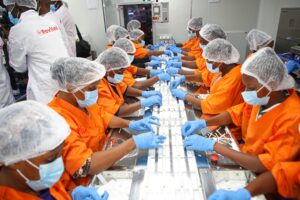Marburg Virus Outbreak Sparks Panic in East Africa as Rwanda, America Consider Travel Bans
Symptoms of the Deadly Marburg Virus Strike Just 8 to 9 Days Post-Infection, Leading to Sudden Death

Kigali, Oct 08 – Rwanda is grappling with the Marburg virus – a highly infectious disease outbreak that has already claimed the lives of 12 people since it was first reported on September 27. With 49 cases confirmed, medical professionals are particularly the most affected, raising alarm about the nation’s fragile healthcare system. Rwanda’s health sector, characterized by a shortage of medical personnel—including fewer than 40 anesthesiologists for over 13 million people—faces significant strain.
The World Health Organization (WHO) has expressed concern over the potential regional spread of the disease, especially given the confirmed cases in districts close to the borders with the Democratic Republic of the Congo (DRC), Uganda, and Tanzania. In response, Rwandan Health Minister Sabin Nsanzimana announced on October 6 that vaccination efforts against the Marburg virus have commenced, focusing on those at highest risk, particularly healthcare professionals. Rwanda has also received 700 doses of the vaccine from the Sabin Vaccine Institute, a U.S.-based non-profit organization, for use in clinical trials aimed at developing effective treatments.
To combat the outbreak, Rwanda is also set to implement travel restrictions that include temperature checks, passenger questionnaires, and hand sanitizing stations at departure points. The Marburg virus, which is transmitted from fruit bats to humans and through contact with the bodily fluids of infected individuals, has caused previous outbreaks in neighboring Tanzania’s Kagera region in 2023 and resulted in three fatalities in Uganda in 2017.

In Kenya, Health Cabinet Secretary Dr. Deborah Barasa confirmed that while WHO has issued an alert regarding Marburg Virus Disease (MVD), no cases have been reported in the country. She stated that the government has stepped up surveillance efforts along the borders and urged the public to stay vigilant.
The Marburg virus, first identified in Africa in the 1970s, has predominantly been reported in Central and West Africa, with Rwanda now emerging as the latest country to document fatal cases. The disease is classified as a severe zoonotic illness, similar to Ebola, and is associated with a high fatality rate that can vary from 24% to 88% depending on the strain of the virus and the effectiveness of case management. Unfortunately, there is currently no specific vaccine or treatment, making supportive care the primary form of medical intervention.
According to the Africa Centres for Disease Control and Prevention, most of the confirmed cases have involved healthcare workers, with more than 290 contacts traced so far. Symptoms of the virus typically manifest as high fever, severe headache, muscle aches, fatigue, and gastrointestinal distress, such as severe diarrhea and vomiting. Patients usually experience symptoms within 8 to 9 days post-infection, often leading to death shortly thereafter.
While raising the alarm, WHO has also committed to supporting Rwanda in accessing vaccines and treatment doses for clinical trials in response to the dire situation. WHO has also approved ethical protocols for conducting clinical trials on investigational vaccines and treatments during this outbreak. Healthcare experts warn that the virus’s high fatality rate and the potential for rapid spread necessitate urgent international collaboration.
The East African Community (EAC) Secretariat has also called for a coordinated regional response to contain the disease, stating that the outbreak “poses a serious threat to regional health security.”
Andrea Aguer Ariik Malueth, EAC Deputy Secretary General, emphasized the urgency of a collective approach, saying, “There is an urgent need for a coordinated regional response to contain the spread of this highly infectious virus through swift identification, isolation, and treatment of cases and enhanced screening at borders and health facilities.”

In addition to local efforts, the United States has mobilized considerable support for Rwanda in response to the Marburg outbreak. The Biden-Harris Administration has pledged nearly $11 million to address urgent health needs, focusing on enhancing surveillance, contact tracing, and infection prevention measures, including exit screenings at airports and border crossings. The Centers for Disease Control and Prevention (CDC) has deployed three senior scientists to Rwanda to assist in the outbreak response, bringing their expertise in managing viral hemorrhagic fever outbreaks.
Despite the lack of FDA-approved vaccines or treatments for Marburg, the U.S. has provided investigational doses of vaccines and therapeutics in collaboration with pharmaceutical companies to expedite clinical trials for potential countermeasures. The White House has underscored the importance of collective action, stating, “In times of crisis, we must work together to quickly save lives. The Government of Rwanda has taken action to contain this outbreak and protect the health and wellbeing of the Rwandan people, and the United States will continue supporting those efforts.”
As part of this support, researchers at the National Institute of Allergy and Infectious Diseases (NIAID) have made significant advancements in vaccine development for the Marburg virus. A study published in The Lancet revealed that an experimental vaccine using a modified chimpanzee adenovirus demonstrated safety and effectiveness in eliciting immune responses among 40 volunteers. Furthermore, research in EBioMed found that a vesicular stomatitis virus (VSV) platform led to a 100% survival rate in vaccinated cynomolgus macaques.
The establishment of the MVDAC, a WHO-coordinated consortium, aims to enhance collaboration in vaccine development, ensuring that vital resources and information are rapidly shared among stakeholders while addressing the urgent need for preparedness against infectious diseases in the region.
To reduce the risk of contracting the disease, the public has been urged to maintain proper hand hygiene by using soap or alcohol-based sanitizers and avoid contact with fruit bats and their droppings, as these are the virus’s natural hosts. Safe burial practices are essential to minimize exposure to bodily fluids from deceased individuals. Individuals caring for infected patients or handling potential animal reservoirs should wear personal protective equipment (PPE) and avoid contact with nonhuman primates in endemic areas.

Anyone suspecting they may have contracted Marburg virus should seek immediate medical care, as early supportive treatment is crucial for survival. Self-isolation to prevent the spreading of the virus, notify local health authorities, and avoid contact with others, especially through bodily fluids, until a diagnosis is confirmed has also been recommended.
Meanwhile, the U.S. is implementing travel precautions to safeguard its citizens as health experts urge East African countries to adopt robust measures in response to the Marburg outbreak. The interconnectedness of the region through trade and travel necessitates immediate action to prevent the virus from spreading, drawing parallels to the COVID-19 response.
Healthcare experts emphasize that the Marburg outbreak underscores the critical need for enhanced preparedness, highlighting lessons learned during the COVID-19 pandemic. Strengthening health infrastructure, improving surveillance systems, and enhancing response mechanisms across East African nations is vital for safeguarding public health and preventing the escalation of this outbreak.